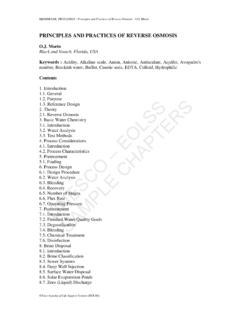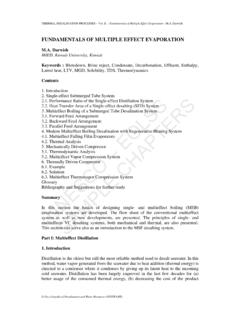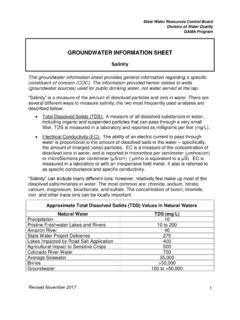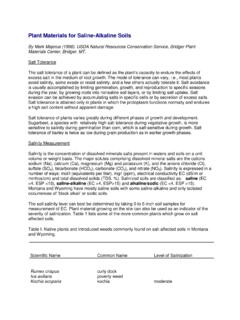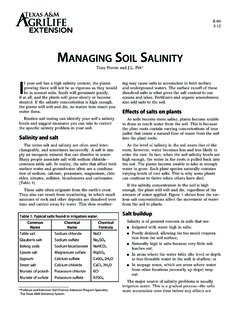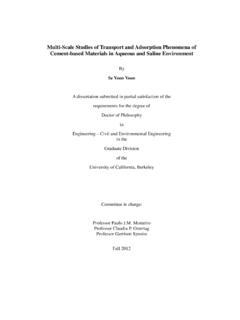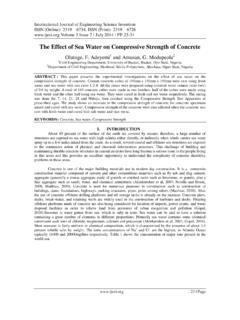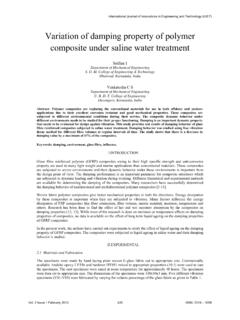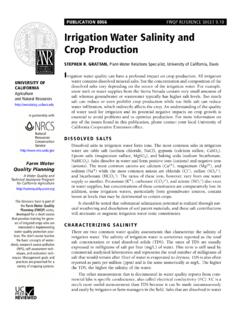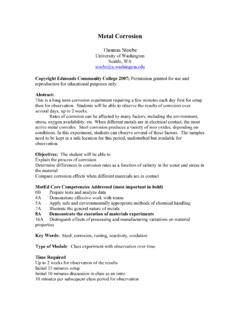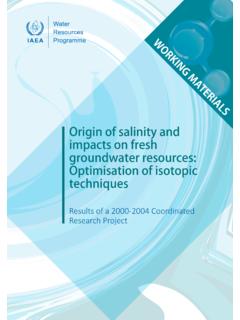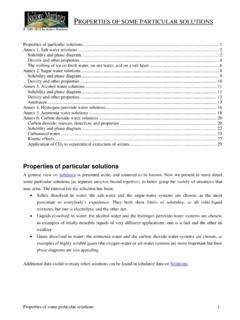Transcription of Freezing Desalination Process
1 UNESCO EOLSSSAMPLE CHAPTERSTHERMAL Desalination PROCESSES Vol. II - Freezing Desalination Process - Z. Lu and L. Xu Encyclopedia of Desalination and water Resources (DESWARE) Freezing Desalination Process Z. Lu and L. Xu Department of Environmental Engineering, East China University of Science and Technology, China Keywords: Counterwasher, Desublime, Desublimate, Indirect Freezing , Supertriple point, Vacuum Freezing Contents 1. Introduction 2. Desalination Freezing Process Basic Components in the Freezing Processes Indirect Freezing Process Direct Freezing Processes 3. Comments on Freezing Processes 4. Future Prospects Acknowledgements Glossary Bibliography and Suggestions for further study Summary Desalination by Freezing processes is based on the fact of that ice crystals are made up of essentially pure water .
2 It consists of three discrete steps: ice formation, ice cleaning, and ice melting. Because it has a number of advantages, low energy requirements, immunity of fouling and corrosion or scaling as well as almost no pre-treatment etc., the Freezing Process has been developed rapidly during the past 50 years. Although more efforts have been undertaken, Desalination by Freezing is still in the form of studies and pilot plant units; attempts at its commercial application have not been successful until now. This chapter presents a retrospect to the historical development of the Freezing Process and describes the basic flow diagram of each Freezing Process . The principles of the Process and functions of the major Process components are discussed in detail. The advantages and disadvantages of each Process are commented on.
3 The Freezing Process will be used widely in the field of industrial waste water treatment and food industry in the future. The combination of Freezing processes and other Desalination processes can reduce the rejected brine from Desalination and produce various salts from seawater. 1. Introduction Desalination by Freezing processes is based on the fact that, in physical chemistry, ice crystals formed are made up of essentially pure water when the temperature of saline water is lowered to its Freezing point and further heat is removed. In fact it is the nature of all crystals that impurities are excluded from the crystals' structures as they grow. In contrast to distillation, the Freezing method utilizes the phase change of water from liquid to solid. It requires the separation of the ice crystals from the brine, cleaning of the ice crystals to remove the adhering salts on the crystals surface, and melting of the UNESCO EOLSSSAMPLE CHAPTERSTHERMAL Desalination PROCESSES Vol.
4 II - Freezing Desalination Process - Z. Lu and L. Xu Encyclopedia of Desalination and water Resources (DESWARE) ice to produce fresh water . Compared to other Desalination processes, particularly the distillation Process , the Freezing Process offers a number of advantages. It requires the transfer of less energy, needs almost no pretreatment, and has minimal corrosion and metallurgical problems. Theoretically, to freeze 1 kg of water requires the heat removal of only approximately 80 kcal; the evaporation of 1 kg of water requires the addition of approximately 600 kcal. The energy required to carry out the Process is thus potentially reduced. Because the Freezing Process is operated at low temperature (about -3 C), it greatly reduces the problems of scale formation and corrosion, which are very troublesome in all forms of distillation.
5 This permits a wider selection of materials and construction methods. Another advantage of the Freezing Process is that it is relatively insensitive to changes in the concentration or type of substances in the feedwater. It is suitable for difficult brackish water with a high salt content and even industrial or wastewater, which cannot be desalted by membrane processes. These attractive features of the Process have stimulated considerable investigation since the 1950s. Colt Industries first began development of the vacuum- Freezing vapor compression (VFVC) desalting Process in 1960 and the capacity of its pilot was increased from 60 000 to 120 000 gal day-1 (227 to 554 m3 day-1). In 1969, Colt Industries demonstrated reliable performance of units with 100 000 gpd (379 m3 d-1) capacity and had proposed units with 500 000 gal day-1 (1893 m3 day-1) capacity.
6 On the base of the VFVC Process , other vacuum- Freezing Process were further developed rapidly and the pilot units were operated successfully, the vacuum- Freezing vapor absorption (VFVA) Process , vacuum- Freezing ejector absorption (VFEA) Process , vacuum- Freezing high pressure ice-melting (VFPIM) Process , and vacuum- Freezing multiple phase transformation (VFMPT) Process . During the same period, another interesting variation of the direct Freezing Process , the secondary refrigerant Freezing (SRF) Process , was developed too. Karnofsky and Steinhoff (1960) and Weigandt (1960) first proposed the saline water conversion by direct Freezing Process with butane as the secondary refrigerant in 1960. AVCO Corperation designed and manufactured the 75 000 gal day-1 (284 m3 day-1) secondary refrigerant Freezing (SRF) pilot plant in which R-114 (dichlorotetrafluoroethane) was used as the refrigerant and demonstrated the SRF Process at a capacity of up to 100 000 gal day-1 (379 m3 day-1).
7 Although more efforts had been undertaken, Desalination by Freezing was still in the form of studies and pilot plant units; attempts at commercial application have not been successful till now. The principle problems in Freezing Process may be the separation of the ice crystals from the concentrated brine and the unsuitability of conventional refrigerant compressors. The recent invention and development of the hydraulic refrigerant compressor may provide a solution to the compressor problems. Rice and Chau (1997) described such a compressor and the characteristics of the resulting freeze Desalination system. 2. Desalination Freezing Processes Basic Components in the Freezing Processes Freezing of salt water can be carried out in many ways. Any Process involves three discrete steps in obtaining fresh water from a saline source: ice formation by the heat UNESCO EOLSSSAMPLE CHAPTERSTHERMAL Desalination PROCESSES Vol.
8 II - Freezing Desalination Process - Z. Lu and L. Xu Encyclopedia of Desalination and water Resources (DESWARE) removal of saline water , separation of ice from the brine, and melting of the ice. Therefore, almost all Freezing processes utilize functional components because they utilize similar mechanisms for forming ice and separation from the brine. There are four basic components in all Freezing Desalination processes: Freezer, washer, melter, and heat removal systems. The freezer consists of a vessel in which ice crystals and vapor are formed simultaneously. The various Freezing processes generally differ in the apparatus which removes heat from the brine in order to produce ice crystals which can be easily transferred, removed, separated, washed, and then melted.
9 The heat removed in the Freezing Process is usually transferred to the melter where it is utilized for melting the ice. The design and operation of the freezer are two keys to producing a high proportion of discrete ice crystals rather than clumps of ice so that the amount of brine trapped between the crystals formed is minimized. The size of the crystals formed is very important because fine crystals are difficult to wash. The nucleation and growth rate of ice crystals is always of interest in the Desalination of seawater by Freezing which has been discussed elsewhere (see below). Ice crystals formed in the freezer are pumped as slurry to the washer where the ice crystals are separated from the brine. The counter current wash column is usually utilized as the washer, in which a small part of the product water , flowing in a direction counter to that of the ice motion, is used to wash the ice to remove the brine adhering to the crystal surfaces.
10 Two variations of the wash separation column called the "gravity" and "pressurized" wash separation columns have proven to be technically feasible and the choice between the two must be made from an economic standpoint based on a specific Process application. In the melter the ice from the washer is usually melted by transferring the heat of crystallization removed from the brine in the freezer to the melter. This is usually done by discharging the refrigerant into the melter, where the ice picks up heat and melts. Because all Freezing processes operate at temperatures below ambient, the heat must be removed from the system continuously. Heat removal can be accomplished by evaporating refrigerant, compression vapor, and heat exchanging from product fresh water or concentrated brine, etc. Different methods of heat removal will result in different Desalination Freezing processes.


